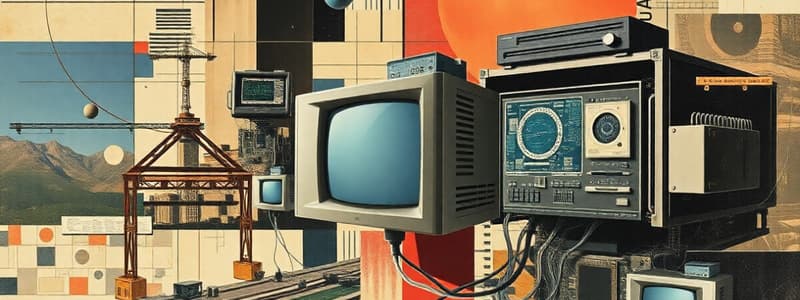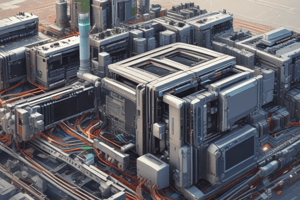Podcast
Questions and Answers
Which basic function of a computer involves manipulating data to produce meaningful information?
Which basic function of a computer involves manipulating data to produce meaningful information?
- Data processing (correct)
- Control
- Data storage
- Data movement
What function of a computer is responsible for saving and retrieving data?
What function of a computer is responsible for saving and retrieving data?
- Control
- Data movement
- Data storage (correct)
- Data processing
Which function would be most closely associated with executing commands and managing system resources?
Which function would be most closely associated with executing commands and managing system resources?
- Data storage
- Data processing
- Data movement
- Control (correct)
In the context of computer functions, which operation involves transferring data from one location to another?
In the context of computer functions, which operation involves transferring data from one location to another?
Which function is essential for coordinating the activities within the computer system?
Which function is essential for coordinating the activities within the computer system?
What is one of the key benefits of the same architecture in customer software investment?
What is one of the key benefits of the same architecture in customer software investment?
Which product line has maintained its architecture over time, demonstrating its longevity?
Which product line has maintained its architecture over time, demonstrating its longevity?
What is one of the primary functions of the CPU in a computer?
What is one of the primary functions of the CPU in a computer?
Which operation is directly involved in managing data flow within a computer system?
Which operation is directly involved in managing data flow within a computer system?
What might be a consequence of using different architectures in software development?
What might be a consequence of using different architectures in software development?
Which of the following best describes data processing?
Which of the following best describes data processing?
Which statement best describes the concept of architecture as used in this context?
Which statement best describes the concept of architecture as used in this context?
What is implied about architecture in the context of IBM's products?
What is implied about architecture in the context of IBM's products?
Which operation is concerned primarily with the organization and preservation of data?
Which operation is concerned primarily with the organization and preservation of data?
In the context of computer operations, which aspect does NOT belong to the main functions of a computer?
In the context of computer operations, which aspect does NOT belong to the main functions of a computer?
What is the primary focus of a designer when handling a system's components?
What is the primary focus of a designer when handling a system's components?
In the context of designing systems, which aspect is a designer primarily concerned with?
In the context of designing systems, which aspect is a designer primarily concerned with?
Why is it essential for designers to focus on only one level of the system at a time?
Why is it essential for designers to focus on only one level of the system at a time?
Which statement reflects a misconception about a designer's approach in systems design?
Which statement reflects a misconception about a designer's approach in systems design?
What should a designer avoid when dealing with system components?
What should a designer avoid when dealing with system components?
What component is primarily responsible for executing arithmetic and logical operations in the CPU?
What component is primarily responsible for executing arithmetic and logical operations in the CPU?
Which of the following components coordinates the operations of the CPU?
Which of the following components coordinates the operations of the CPU?
In a CPU, which part is responsible for temporarily storing data that is being processed?
In a CPU, which part is responsible for temporarily storing data that is being processed?
What role does the CPU interconnection play within the computer architecture?
What role does the CPU interconnection play within the computer architecture?
Which of the following statements is true regarding the ALU?
Which of the following statements is true regarding the ALU?
What type of resources can be found on the mentioned website?
What type of resources can be found on the mentioned website?
What is one function of the website linked for the book?
What is one function of the website linked for the book?
Which of the following is not mentioned as a feature of the website?
Which of the following is not mentioned as a feature of the website?
What type of information can users expect to find regarding the book on the website?
What type of information can users expect to find regarding the book on the website?
What is the primary purpose of the website mentioned in the content?
What is the primary purpose of the website mentioned in the content?
Flashcards
Architecture of a product line
Architecture of a product line
The consistent design and structure of a product line, ensuring compatibility and minimizing software changes for users.
IBM's Mainframe Architecture
IBM's Mainframe Architecture
The mainframe product line of IBM has retained its fundamental architectural design over many years.
System Decomposition
System Decomposition
The process of dividing a system into smaller, manageable parts, each with a specific purpose.
Hierarchical System Architecture
Hierarchical System Architecture
Signup and view all the flashcards
Level of Abstraction
Level of Abstraction
Signup and view all the flashcards
System Structure
System Structure
Signup and view all the flashcards
System Function
System Function
Signup and view all the flashcards
Data Processing
Data Processing
Signup and view all the flashcards
Data Storage
Data Storage
Signup and view all the flashcards
Data Movement
Data Movement
Signup and view all the flashcards
Control
Control
Signup and view all the flashcards
Basic Computer Functions
Basic Computer Functions
Signup and view all the flashcards
Control operation
Control operation
Signup and view all the flashcards
Computer Structure
Computer Structure
Signup and view all the flashcards
What is the CPU?
What is the CPU?
Signup and view all the flashcards
What is the Control Unit?
What is the Control Unit?
Signup and view all the flashcards
What is the ALU?
What is the ALU?
Signup and view all the flashcards
What are Registers?
What are Registers?
Signup and view all the flashcards
What is the CPU interconnection?
What is the CPU interconnection?
Signup and view all the flashcards
Book Website
Book Website
Signup and view all the flashcards
Links of Interest
Links of Interest
Signup and view all the flashcards
Course Links
Course Links
Signup and view all the flashcards
Errata List
Errata List
Signup and view all the flashcards
Information on [Book]
Information on [Book]
Signup and view all the flashcards
Study Notes
Computer Organization and Architecture
- The field encompasses the structure and function of computers.
- Chapter 1 introduces core concepts.
Chapter 1: Introduction
- This chapter details foundational ideas.
Computer Architecture
- Attributes visible to programmers directly impact program execution.
- Hardware details are hidden from programmers.
Computer Organization
- Instruction sets and data representations are included.
- Memory addressing techniques are incorporated.
IBM System/370 Architecture
- Introduced in 1970, it included numerous models.
- Upgrades were possible without abandoning existing software.
- Design allows for new models without affecting existing software.
Structure and Function
- Hierarchical systems consist of interconnected subsystems.
- Structure describes how components relate.
- Function explains individual component operations within the system context.
Function of a Computer
- Computers complete four fundamental tasks.
- Data Processing
- Data Storage
- Data Movement
- Control
Computer Operations
- Diagrams (Figures 1.1-1.2) illustrate how data flows through processing, storage, and movement.
The Computer
- The computer includes storage, processing, and peripherals.
- Communication links connect various components.
Computer Structure
- Detailed CPU architectural diagrams (Figure 1.4) display the interconnections, control units, I/O, and main memory.
Main Components
- CPU: controls operations and performs data processing.
- Main Memory: Stores data.
- I/O: Transfers data between the computer and the external environment.
- System Interconnection: Facilitates communication among CPU, main memory, and I/O.
CPU Structure
- Major components:
- Control Unit
- Arithmetic Logic Unit (ALU)
- Registers
- CPU Interconnection
Summary
- Four primary structural elements are detailed.
- Chapter 1 encapsulates computer organization, architecture, and function.
Studying That Suits You
Use AI to generate personalized quizzes and flashcards to suit your learning preferences.




